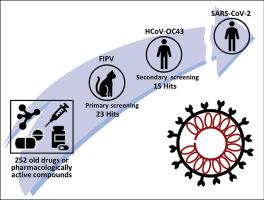Biomedical Journal ( IF 4.1 ) Pub Date : 2020-05-23 , DOI: 10.1016/j.bj.2020.05.003 Cheng-Wei Yang , Tzu-Ting Peng , Hsing-Yu Hsu , Yue-Zhi Lee , Szu-Huei Wu , Wen-Hsing Lin , Yi-Yu Ke , Tsu-An Hsu , Teng-Kuang Yeh , Wen-Zheng Huang , Jiunn-Horng Lin , Huey-Kang Sytwu , Chiung-Tong Chen , Shiow-Ju Lee

|
Background
New therapeutic options to address the ongoing coronavirus disease 2019 (COVID-19) pandemic are urgently needed. One possible strategy is the repurposing of existing drugs approved for other indications as antiviral agents for severe acute respiratory syndrome coronavirus-2 (SARS-CoV-2). Due to the commercial unavailability of SARS-CoV-2 drugs for treating COVID-19, we screened approximately 250 existing drugs or pharmacologically active compounds for their inhibitory activities against feline infectious peritonitis coronavirus (FIPV) and human coronavirus OC43 (HCoV-OC43), a human coronavirus in the same genus (Betacoronavirus) as SARS-CoV-2.
Methods
FIPV was proliferated in feline Fcwf-4 cells and HCoV-OC43 in human HCT-8 cells. Viral proliferation was assayed by visualization of cytopathic effects on the infected Fcwf-4 cells and immunofluorescent assay for detection of the nucleocapsid proteins of HCoV-OC43 in the HCT-8 cells. The concentrations (EC50) of each drug necessary to diminish viral activity to 50% of that for the untreated controls were determined. The viabilities of Fcwf-4 and HCT-8 cells were measured by crystal violet staining and MTS/PMS assay, respectively.
Results
Fifteen out of the 252 drugs or pharmacologically active compounds screened were found to be active against both FIPV and HCoV-OC43, with EC50 values ranging from 11 nM to 75 μM. They are all old drugs as follows, anisomycin, antimycin A, atovaquone, chloroquine, conivaptan, emetine, gemcitabine, homoharringtonine, niclosamide, nitazoxanide, oligomycin, salinomycin, tilorone, valinomycin, and vismodegib.
Conclusion
All of the old drugs identified as having activity against FIPV and HCoV-OC43 have seen clinical use in their respective indications and are associated with known dosing schedules and adverse effect or toxicity profiles in humans. Those, when later confirmed to have an anti-viral effect on SARS-CoV-2, should be considered for immediate uses in COVID-19 patients.
中文翻译:

重新使用旧药物作为冠状病毒的抗病毒剂。
背景
迫切需要新的治疗方案来应对不断发展的2019年冠状病毒病(COVID-19)。一种可能的策略是重新批准已被批准用于其他适应症的现有药物,作为重症急性呼吸综合征冠状病毒2(SARS-CoV-2)的抗病毒药。由于SARS-CoV-2药物在商业上尚无法用于治疗COVID-19,因此,我们针对它们对猫传染性腹膜炎冠状病毒(FIPV)和人冠状病毒OC43(HCoV-OC43)的抑制活性,筛选了约250种现有药物或药理活性化合物,与SARS-CoV-2相同属的人类冠状病毒(Betacoronavirus)。
方法
FIPV在猫Fcwf-4细胞和HCoV-OC43在人HCT-8细胞中增殖。通过可视化对感染的Fcwf-4细胞的细胞病变作用和免疫荧光测定法检测病毒的增殖,以检测HCT-8细胞中HCoV-OC43的核衣壳蛋白。确定了将病毒活性降低至未处理对照的50%所需的每种药物的浓度(EC 50)。Fcwf-4和HCT-8细胞的活力分别通过结晶紫染色和MTS / PMS测定来测量。
结果
发现筛选出的252种药物或药理活性化合物中有15种对FIPV和HCoV-OC43均具有活性,EC 50值为11 nM至75μM 。它们都是如下的旧药:阿霉素,抗霉素A,阿托伐醌,氯喹,康尼伐普坦,依米替丁,吉西他滨,高哈灵顿碱,烟酰胺,硝唑尼特,低聚霉素,沙利霉素,替洛龙,缬氨霉素和维莫昔布。
结论
所有被鉴定为具有抗FIPV和HCoV-OC43活性的旧药物均已在其各自适应症中得到临床应用,并与已知的给药方案以及对人体的不良反应或毒性有关。那些后来被证实对SARS-CoV-2具有抗病毒作用的药物,应考虑立即用于COVID-19患者。











































 京公网安备 11010802027423号
京公网安备 11010802027423号